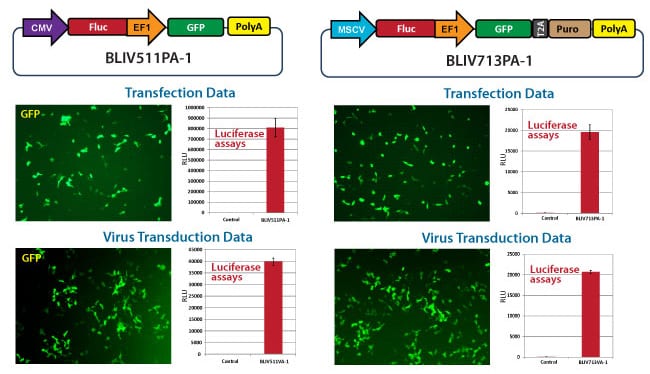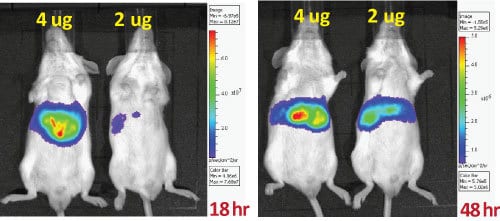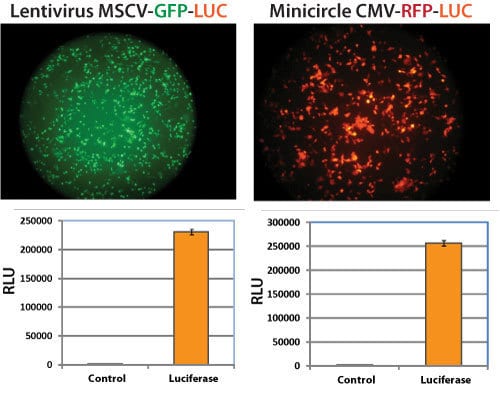MSCV-Luciferase-RFP-TK Lentivector for In Vivo Imaging
- You’re working with difficult-to-transfect cells
- You’d like to create stable reporter cell lines
- You’d like to integrate your reporter into the genome
- You’d like episomal expression
- You’d like to avoid introducing foreign sequences
Products
| Catalog Number | Description | Size | Price | Quantity | Add to Cart | |||
|---|---|---|---|---|---|---|---|---|
| BLIV302PA-1 | Lentiviral Triple Reporter: MSCV-Luciferase-RFP-TK plasmid | 10 µg | $779 |
|
||||
| BLIV302VA-1 | Lentiviral Triple Reporter: MSCV-Luciferase-RFP-TK pre-packaged virus | >2 x10^6 IFUs | $779 |
|
||||
Overview
Overview
Clearly visualize cells in vivo and ex vivo for tracking cell fate and more
Easily label cell lines for tracking cell fate after implantation in an animal model or other imaging applications with SBI’s line of Bioluminescent, Fluorescent, and PET Imaging Vectors (BLIV). Available in a variety of promoter-reporter combinations that enable multiple imaging modalities—fluorescence with copGFP, bioluminescence with luciferase, and positron emission tomography (PET) with thymidine kinase (TK)—you can select from lentivector or minicircle technologies for both integrated and episomal expression.
SBI's lentivector-based imaging systems offer safe, stable, and effective gene delivery in virtually all mammalian cells in tissue culture and in whole animal models.
The MSCV-Luciferase-RFP-TK Lentivector for In Vivo Imaging leverages SBI’s well-regarded lentivector technology for either transduction or transfection of the reporter into target cells. Because the vector becomes integrated into the genome, you can use this vector to create stable reporter cell lines.
The vector expresses Luciferase, RFP, and TK from an MSCV promoter for high expression in hematopoietic and stem cells. Available as either a plasmid or pre-packaged virus.
Which BLIV construct should you choose?
With a range of options, SBI’s vectors for in vivo imaging support a wide range of projects. Simply choose the vector that best fits your needs:
Choose a lentivector when:
- You’re working with difficult-to-transfect cells
- You’d like to create stable reporter cell lines
- You’d like to integrate your reporter into the genome
Choose a minicircle vector* when you’re working with transfectable cells and:
- You’d like episomal expression
- You’d like to avoid introducing foreign sequences
Choose your promoter using the following table:
| Promoter | Expression Level | Application |
|---|---|---|
| CMV | High | Commonly used in most cell lines (HeLa, HEK293, HT1080, etc.) |
| MSCV | High | Hematopoietic and stem cells |
| EF1α | Medium | Most cell types including primary cells and stem cells |
| PGK | Medium | Most cell types including primary cells and stem cells |
| UbC | Low | Most cell types including primary cells and stem cells |
*Note that Minicircle Parental Vectors are only available to academic/non-profit customers. Researchers at commercial organization may only purchase the pre-made minicircle BLIVs.
References
How It Works
Supporting Data
Supporting Data
See SBI’s BLIV Vectors in action
Figure 1. Examples of how SBI’s BLIV lentivectors deliver strong luciferase activity after both transduction and transfection.
Figure 2. Examples of how SBI’s BLIV minicircle vectors deliver strong luciferase activity in small animal models.
Figure 3. Examples of how SBI’s BLIV lentivectors and minicircle vectors can be used to generate stable cell lines with strong luciferase activity.
FAQs
Documentation
Citations
Related Products
Products
| Catalog Number | Description | Size | Price | Quantity | Add to Cart | |||
|---|---|---|---|---|---|---|---|---|
| BLIV302PA-1 | Lentiviral Triple Reporter: MSCV-Luciferase-RFP-TK plasmid | 10 µg | $779 |
|
||||
| BLIV302VA-1 | Lentiviral Triple Reporter: MSCV-Luciferase-RFP-TK pre-packaged virus | >2 x10^6 IFUs | $779 |
|
||||
Overview
Overview
Clearly visualize cells in vivo and ex vivo for tracking cell fate and more
Easily label cell lines for tracking cell fate after implantation in an animal model or other imaging applications with SBI’s line of Bioluminescent, Fluorescent, and PET Imaging Vectors (BLIV). Available in a variety of promoter-reporter combinations that enable multiple imaging modalities—fluorescence with copGFP, bioluminescence with luciferase, and positron emission tomography (PET) with thymidine kinase (TK)—you can select from lentivector or minicircle technologies for both integrated and episomal expression.
SBI's lentivector-based imaging systems offer safe, stable, and effective gene delivery in virtually all mammalian cells in tissue culture and in whole animal models.
The MSCV-Luciferase-RFP-TK Lentivector for In Vivo Imaging leverages SBI’s well-regarded lentivector technology for either transduction or transfection of the reporter into target cells. Because the vector becomes integrated into the genome, you can use this vector to create stable reporter cell lines.
The vector expresses Luciferase, RFP, and TK from an MSCV promoter for high expression in hematopoietic and stem cells. Available as either a plasmid or pre-packaged virus.
Which BLIV construct should you choose?
With a range of options, SBI’s vectors for in vivo imaging support a wide range of projects. Simply choose the vector that best fits your needs:
Choose a lentivector when:
- You’re working with difficult-to-transfect cells
- You’d like to create stable reporter cell lines
- You’d like to integrate your reporter into the genome
Choose a minicircle vector* when you’re working with transfectable cells and:
- You’d like episomal expression
- You’d like to avoid introducing foreign sequences
Choose your promoter using the following table:
| Promoter | Expression Level | Application |
|---|---|---|
| CMV | High | Commonly used in most cell lines (HeLa, HEK293, HT1080, etc.) |
| MSCV | High | Hematopoietic and stem cells |
| EF1α | Medium | Most cell types including primary cells and stem cells |
| PGK | Medium | Most cell types including primary cells and stem cells |
| UbC | Low | Most cell types including primary cells and stem cells |
*Note that Minicircle Parental Vectors are only available to academic/non-profit customers. Researchers at commercial organization may only purchase the pre-made minicircle BLIVs.
References
How It Works
Supporting Data
Supporting Data
See SBI’s BLIV Vectors in action
Figure 1. Examples of how SBI’s BLIV lentivectors deliver strong luciferase activity after both transduction and transfection.
Figure 2. Examples of how SBI’s BLIV minicircle vectors deliver strong luciferase activity in small animal models.
Figure 3. Examples of how SBI’s BLIV lentivectors and minicircle vectors can be used to generate stable cell lines with strong luciferase activity.




